African Americans have played a foundational role in the creation, growth, and development of Arlington, Virginia. Although an underrepresented story of the African American experience, this rich history begins with the seminal role of Black enslaved people in the construction of national landmarks such as Arlington House and the Arlington National Cemetery, leading to the establishment of Arlington’s free Black community with Freedmans Village.
This history continues into the 20th century with African Americans organizing neighborhoods and making gains in the community of Arlington while taking an active role in the pursuit of social justice during the Civil Rights Movement. From the era of slavery to the present day, this exhibit explores the ways that African Americans have influenced, shaped, and enriched the culture and community of Arlington, Virginia
This virtual exhibit highlights some of the artifacts the Arlington Historical Museum currently has on permanent display in its African-American Experience exhibit.
These artifacts are by no means the full story of the history of African-Americans in Arlington but the Arlington Historical Society is honored to have received many of these artifacts as permanent or temporary donations and each represents some highlights of the African-American experience in our community.
“From the slaves who built Arlington House one brick at a time to the government, civic, and business leaders who are building the framework for our future, the history of African-Americans in Arlington – and their important contributions to our community and society – is a 200-year old work in progress.”
Dr. Talmadge T. Williams (1934-2014)
Past Chairman of the Black Heritage Museum of Arlington
Past President of Arlington Branch of the NAACP
The Second Regiment United States Colored Infantry
During the Civil War, Virginia contributed over 5,000 men to the United Stated Colored Infantry (USCI). Among those mustered into service were many African American troops who hailed from parts of Virginia as well as Maryland, North Carolina, and Washington, D.C. Most Virginia based USCI units consisted of free Blacks, “contraband” or those freed by US Army troops, and escaped African Americans from the US Army-controlled Tidewater area and Northern Virginia. Two units of the USCI were organized here in Arlington: the 2nd and the 23rd Regiments of the USCI.
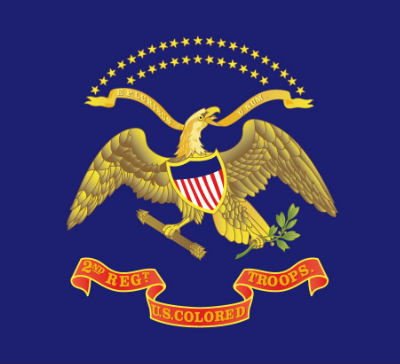
Regimental Colors, 2nd Regiments of the US Colored Troops
By mid 1862, after a year of war and under increasing pressure to strengthen the military force of the United States, Congress amended the Militia Act to remove the ban on African Americans in the army and navy. By late summer three regiments of the “Louisiana Native Guard,” as well as the First Kansas and the First South Carolina had been mustered in and deployed on active service.
Recruitment vastly increased after the Emancipation Proclamation. Governor Andrew of Massachusetts raised the 54th Massachusetts of “Glory” fame. Adjutant General Lorenzo Thomas traveled west to raise “African Descent” regiments from “contrabands” along the Mississippi. And in May, 1863, the War Department established the “Bureau of Colored Troops” to oversee both the enlistment of African American soldiers and the examination and appointment of their officers on a national basis.
The first Black troops raised directly by the War Department were the “First District of Columbia Colored Volunteers,” soon redesignated the First United States Colored Troops, organized on Mason’s Island (today Roosevelt Island) within the District of Columbia. By summer what some called the “Second District” began organizing at Camp Casey in Arlington.
Raising these troops directly gave the War Department the flexibility to bring enlistees from multiple recruiting stations to centralized camps of organization regardless of state boundaries, and there combine them into larger units. And so the companies of the Second United States Colored Infantry came from Norfolk, Arlington, Washington, and Baltimore. About two-thirds of the men were recruited in Washington or Arlington. In addition to refugees from enslavement working for the army as laborers or teamsters they included waiters, barbers, blacksmiths, farmers, oystermen, sailors, and many other trades. Around a fifth were free when the war started, including nearly 20 Black men drafted in New York and Pennsylvania and assigned by the Bureau of Colored Troops to the Second, probably to ensure sufficient literate men to fill the non-commissioned officer ranks.[1]
Throughout the summer and into the fall of 1863 the months of training and the dedication of the men meant that by Thanksgiving as they left for the front one of their officers could describe them drilling with “an efficiency and exactness, that perhaps not a regiment in the service, regular or volunteer, surpassed it. With shining muskets, and white gloves, and glittering brasses, and a light, springy step which constant drill had made. they looked the very beau ideal of Black soldiery…”[2]

“Bob Logic” a correspondent of the Weekly Anglo-African wrote that after meeting the early recruits at Camp Casey their handshakes left his arm feeling, “as if it had been using sledgehammers all day, and here let me assure you when these boys get into battle, somebody will be hurt.”[3]
Leaving New York on the steamship Continental for the Gulf, they made a brief stop in New Orleans before encamping on Ship Island, Mississippi. Here for a moment it seemed the first people who might “be hurt” would be each other for, on December 29, a fight broke out just after reveille in Company I from Baltimore. When their officers tried to break it up the men began throwing stones. Worse, several grabbed their muskets. In the crisis the Colonel called out Company B, the Portsmouth men, and ordered them to load. That quickly calmed the disturbance.
After a few more weeks of training at Ship Island the Second sailed for their new station in Key West. Arriving in February 1864, they would have three missions:
-
- First, garrison Fort Taylor and guard Key West. This port was the base of the Navy’s East Gulf Blockading Squadron, whose hunting ground covered the Florida coast from Cape Canaveral to Pensacola.
-
- Second, support and protect White and Black refugees in coastal Florida. When the war began more than four out of every ten Floridians were enslaved and just over a third of White families enslaved Black people. However a number of Whites resented the rebellion and the conscription it brought and were ready to actively support the United States government.
-
- Third, conduct raids into the interior to break up rebel supply lines. In 1860 nearly 400,000 cattle roamed Florida, with much of the total concentrated in the Tampa region south. After Vicksburg fell, these cattle became increasingly valuable as a source of beef for the rebels.
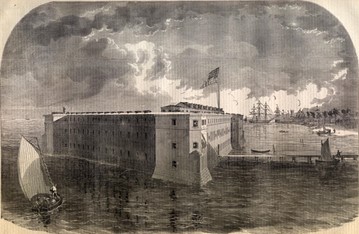
Fort Taylor, Harper’s Weekly, March 2, 1861
By mid-April, 1864 the Second had settled in at Key West detached three companies to the coast to garrison Fort Myers and Cedar Keys, bracketing both ends of the two hundred miles of cattle country between them. Two more would join them in May after a raid on Tampa that effectively deprived the rebels of the port for the rest of the war.
Unfortunately for the Second, in late April a deadlier enemy than the rebels — Yellow Fever — appeared at Key West . By the time the disease came under control more than half the Second’s officers at Key West would perish. Strangely, though many got sick, only four enlisted men died from the disease. And what kept the regiment together during this time were its non-commissioned officers: Sergeant Major Theodore Brown of Binghampton, New York; Commissary Sergeant James Taylor of Albemarle, Virginia, and the 1st Sergeants, Sergeants, and Corporals of the companies of the garrison.

Key West in 1862, William Waud, Library of Congress https://www.loc.gov/item/2004661363/
But as fever played havoc with the officers at Key West, the Second did much the same to rebel supply lines. From May to August, during the height of the season for cattle driving, companies of the Second teamed with the 2nd Florida Cavalry (US), themselves mostly former cowmen. Together the United States Colored Troops and their “Cow Hunter” allies struck repeatedly at the “Cow Cavalry” sent by the rebels to obtain the herds. In this odd war fought at the far extensions of both sides’ supply lines, these small groups of men sparred in the wilderness over a strategic resource that had become more vital than cotton.
In May the U.S. forces, having cleared out rebel supplies at Tampa, hit the Cow Cavalry’s main base at Fort Meade, burning it to the ground. In July, at Station No. 4 on the Florida Railroad, a fight occurred in which platoon of the Second under Sergeant William Wilson routed another rebel force with a bayonet charge. In August, raids on Bay Port, Clay Landing, and Rialls Creek further hampered the collection of cattle for the rebel army. As the fighting ebbed the work of rounding up cattle went on, much to the benefit of U.S. forces throughout the Gulf.
Fighting reignited in February 1865 with the two Seconds again raiding Station No. 4 and the Cow Cavalry replying with a dangerous but unsuccessful attack on Fort Myers.
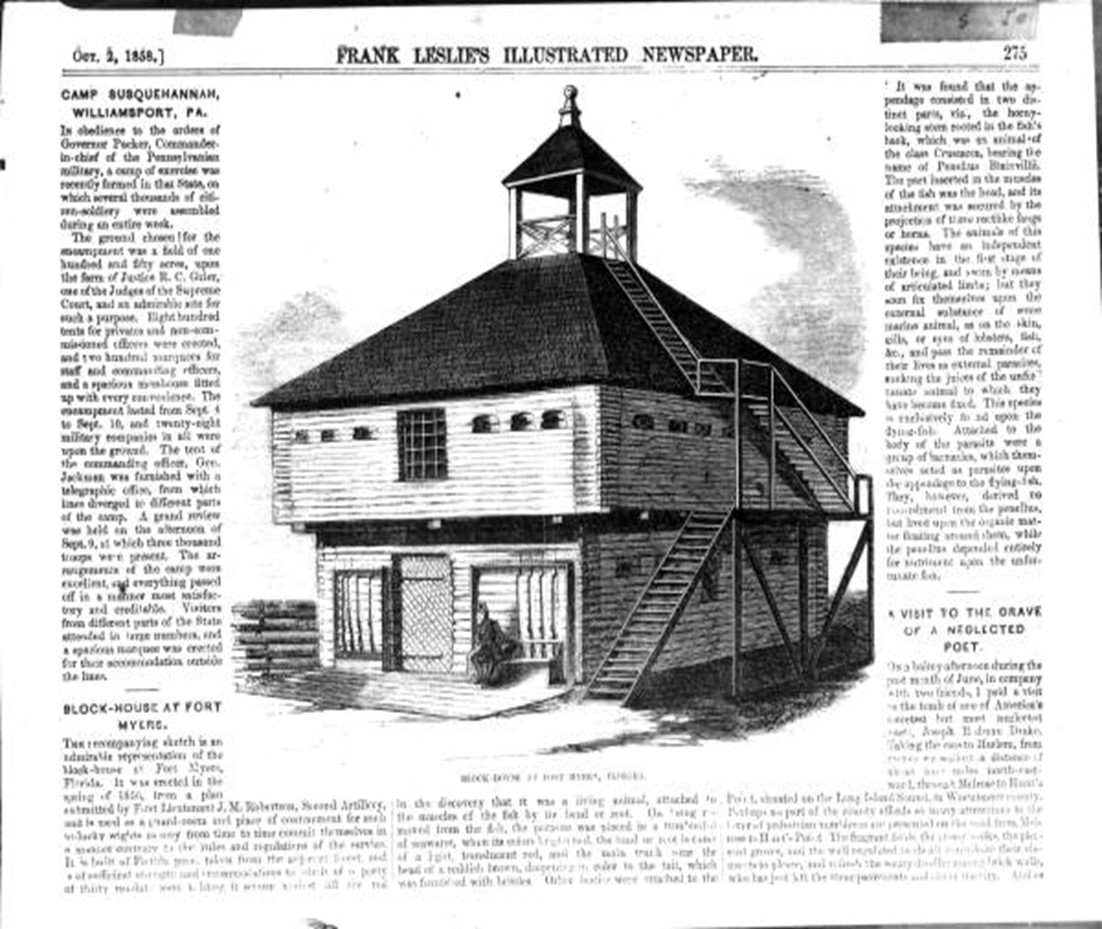
Block House at Fort Myers, Florida, Frank Leslie’s Illustrated Newspaper, October 2, 1858
In March 1865 the Second struck back, fighting their last and greatest battle at Natural Bridge, between St. Marks and Tallahassee. Together with Louisiana Creoles of the 99th USCI, six companies of the Second boarded the gunboats and transports of the East Gulf Blockading Squadron to conduct a large scale raid aiming to surprise local rebel forces and defeat them in detail. Instead they ran into an entrenched army twice their number. They still attacked. After several hours of fighting and the loss of some sixty officers and men, they withdrew in good order, even repelling a rebel attempt to counterattack.
Within a few weeks the Confederacy collapsed altogether and the regiment’s companies dispersed for occupation duties, including at Tallahassee and other key points. In January 1866 they returned to Alexandria and mustered out, receiving six months back pay and bounties. The a sum came to nearly a quarter of a million dollars, leading the local paper to note, “As these men mostly belong to the D. of C., the amount thus put in circulation will be a great relief to many.”[4]
Over the course of the war the Second United States Colored Infantry fought in no major battles, but they put the lie to the idea of “quiet garrison duties.” They secured Key West, liberated a thousand enslaved fellow Americans and recruited more than another hundred freedmen into their ranks from Key West, Cedar Keys, and Fort Myers. Most important, their operations allowed them, in Wilder’s words, “to wax fat on the spoils of the land” while literally starving the rebellion.
Yet their achievements and ambitions went further than those of war:
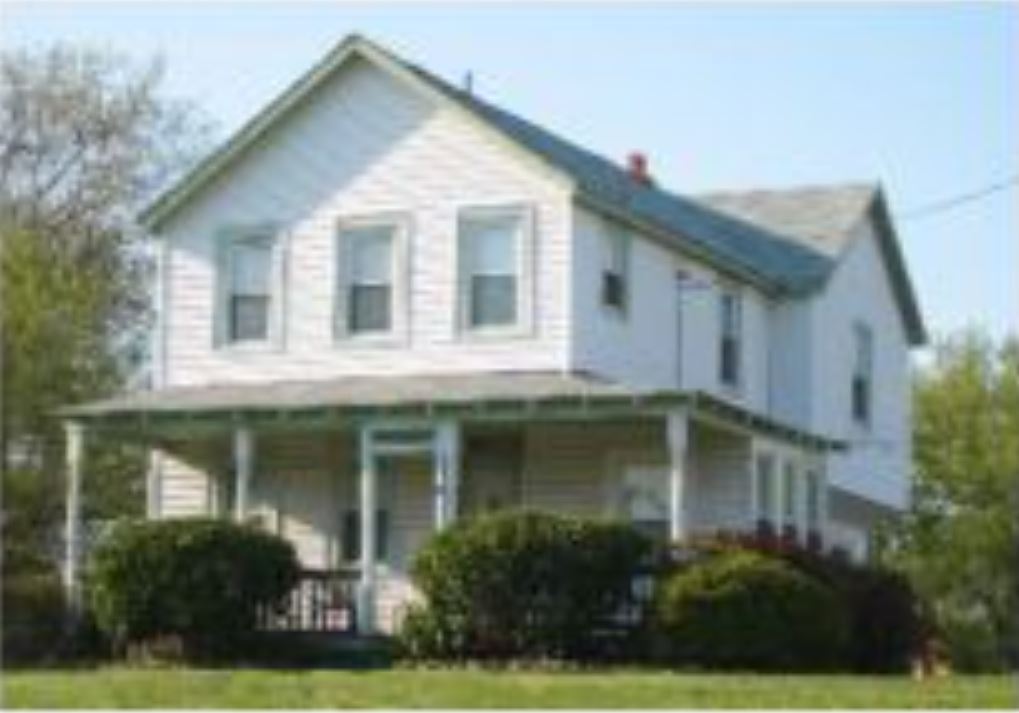
-
- James T. Taylor in addition to his duties on the non-commissioned staff, sent regular updates to the Weekly Anglo-African for the regiment’s families and supporters nation-wide. After the war he went on to a political career that lasted through the rest of the century.[5]
-
- William H. Butler, a 35 year old substitute born in Occoquan, went missing in action and feared dead at Natural Bridge but returned as a discharged prisoner of war to Annapolis in May 1865. Rejoining his family in Arlington he invested in real estate, built a house that his descendants still own (see photo, courtesy Penrose Neighborhood Association), and served in multiple public offices, including as Commissioner of Roads and Supervisor for the Arlington Magisterial District.[6]
-
- Richard Burton, an illiterate farmer from Madison, Virginia made use of the regiment’s school to learn read and write. He displayed such competence that he rose from Private to the regiment’s Quartermaster Sergeant. In recognition of the achievement and its import for the future, he was cited in General Orders as an inspiration to his comrades “for a life of usefulness here after, when they shall no longer be soldiers but become citizens of the United States.”[7]
-
- [1]Data for the men taken from the regimental “Descriptive Book,” in Record Group 94, National Archives
-
- [2]Wilder, John, The Wedding at the Parker House, Putnam’s Monthly, August 1868.
-
- [3]“Letter from Washington,” July 18th, 1863
-
- [4] Alexandria Gazette, January 18, 1866
-
- [5]Bowler, Casey, Black Virginians in Blue, “James T. S. Taylor” http://community.village.virginia.edu/usct/node/97
-
- [6]Liebertz, John Paul, A Guide to the African American Heritage of Arlington County, Virginia, February 4, 2017, pp. 38-41 https://projects.arlingtonva.us/wp-content/uploads/sites/31/2016/09/A-Guide-to-the-African-American-Heritage-of-Arlington-County-Virginia.pdf
-
- [7]G.O. No. 4, April 1, 1865, Order Book for the 2nd USCI, RG 94, National Archives
The 23rd Regiment of the United Stated Colored Infantry
The 23rd Regiment of the United Stated Colored Infantry (USCI) was organized in Arlington (then Alexandria County) at Camp Casey from November 23, 1863 to June 30, 1864. According to Franco Brown of the Black Heritage Museum of Arlington, Camp Casey was likely between Glebe Road, Walter Reed Drive, Columbia Pike, and Arlington Boulevard. The camp was the training ground for Black troops who would have trained separately from white troops.
Near the end of November 1863, shortly after the Second United States Colored Infantry left Camp Casey, a detail of recruits from the Washington depot arrived in their place to erect a new camp and form a new regiment. Like the Second the Twenty-Third would consist of men mostly recruited in Washington and Baltimore, but originating from places throughout the region. Also like their predecessors they would include a large percentage of men enslaved at the beginning of the war. Unlike the Second, however, this second of Arlington’s regiments would be sent to fight closer to home.
Through the winter of 1864 the regiment recruited, drilled, and erected the structures of a permanent camp. There was even a well-attended school in which Emma Beecham, the wife of Lieutenant Beecham of Company B, taught the basics of literacy.[1] The regiment was still recruiting when ordered to the front near the end of April, but, nearly complete, they took trains to Manassas Junction to join the Fourth, or “Black” Division of General Ambrose Burnside’s Ninth Corps — the only division of African American soldiers in the Army of the Potomac.
Because the Black Division was a new formation they were initially assigned to guard the wagon trains and lines of communication of the Army. This was not so peaceful as it seemed as those trains and lines were under constant threat from rebel cavalry and guerrillas. As if to underscore the point, on May 15, 1864 rebel horsemen from Rosser’s Brigade attacked a unit of the 2nd Ohio Cavalry and began driving them back towards the wagons. Fortunately the 23rd was near enough to come to the rescue, double-quicking a half mile to form a line of battle, fix bayonets, and drive back the foe. It was the first direct combat between the United States Colored Troops and Lee’s army.

Coincidentally, the second such combat occurred only nine days later and again another local regiment took part. On May 24, under orders from General Lee, his nephew Fitzhugh attacked Wilson’s Wharf on the James with a picked force of cavalry. The defenders consisted primarily of the 1st USCI — also known as the “First District of Columbia Colored Volunteers.” These men had been in service a year, having formed at Camp Greene on Mason’s (now Roosevelt) Island. The attack was sharply repulsed with substantially more loss to the rebels than the Black soldiers of D.C.[2]
After the exhilaration of their first encounter with the enemy the 23rd USCI went back to more prosaic duties, spending much of June and all of July in the trenches before Petersburg, improving them with pick and shovel under the fire of the rebels. On the night of July 29, however, they massed with the three White divisions of the Corps awaiting the explosion of a mine that would go off the next morning, a mine that would destroy a portion of the rebel defenses and open the way into Petersburg.
The mine exploded, hours after the time scheduled, on July 30 and what followed would be known as the Battle of the Crater. It was a disaster for the United States Army. A huge crater was indeed blown in the rebel defenses, but one by one the three White divisions of the Ninth Corps went forward only to pile up in the crater itself rather than go through. When the Black Division was at last sent in it divided into two portions to go around the confusion in the middle and expanded the hold on the rebel line at that point. But by then the rebels in the second line of defenses had been reinforced, and the one attempt to advance further, out of the crater, was bloodily repulsed.

The 23rd going into action at the Battle of the Crater, Petersburg, 1864. By Alfred Waud
When the remnants of the Ninth Corps were finally withdrawn and the losses tallied the Black Division, which had numbered more than 4,000 men, had lost more than 1,600. These included 176 killed, 688 wounded, and 801 missing. Lieutenant Beecham claimed that some 500 of the USCI were taken prisoner, with the balance of the missing left to become the victims of “cold-blooded and inhuman murders” by the victorious rebels.[3] Among the regiments of the 4th Division the 23rd suffered the greatest loss, including 74 of those killed in action.
Despite that loss the 23rd continued to serve in the lines before Petersburg. It participated in the 9th Corps’ actions on the Weldon Railroad in August, 1864, the further extension of federal siege lines near Peebles Farm at the end of September, and the fighting on the Boyton Plank Road at the end of October. Afterwards they settled in for a long winter of picketing, patrolling, and generally maintaining the lines.
At the beginning of December, 1864, the entire Black Division was combined with the USCI divisions of the 10th and 18th Corps in the Army of the James, to form the 25th Corps of the United States Army — the first and largest African American formation in the history of the United States Army, exceeding even the Black 92nd Division in both World Wars.
The 23rd regiment was assigned to the First Division of this Corps, which on April 3, 1865 claimed the honor of being the first United States troops to march into Richmond. This was a momentous occasion for the entire Corps, but excitement was quickly dampened when they learned their next destination was Texas, a long sea voyage away.

The US Army entering Richmond, on April 3, 1865, from an 1886 illustration in a book edited by Paul Fleury Mottelay titled: “The Soldier in our Civil War a Pictorial History of the Conflict, 1861–1865.”
In Texas the 25th Corps served under General Sheridan in the “Army of Observation” on the Rio Grande. “Observation” in this instance was a euphemism for covert but very real support for President Benito Juarez’s struggle against French occupation and the conservative supporters of Emperor Maximilian. American support would eventually secure the triumph of Juarez and the execution of Maximilian in 1867, but the 23rd had long since returned home leaving other troops to watch the frontier. August of 1865 found them back in Virginia, to formally muster out in November.
For many of the men the world they returned to might have seemed impossible just a few years earlier. Those enslaved, like Peter Churchwell, Andrew Weaver, and Abraham Tuckson from the Fredericksburg area, had the satisfaction of securing their own emancipation in the uniform of the republic. Others like Sergeant Nimrod Burke, originally of Prince William County, had gained freedom before the war, but willingly enlisted to gain that of others.[4] Now at least the first part of their mission had been fulfilled.
The question often arises of how important and effective the United States Colored Troops were. As to importance, perhaps Lincoln said it best when he wrote in September 1864 that,
“We can not spare the hundred and forty or fifty thousand now serving as soldiers, seamen, and laborers. This is not a question of sentiment or taste, but one of physical force…. Keep it and you can save the Union. Throw it away, and the Union goes with it. Nor is it possible for any Administration to retain the service of these people with the express or implied understanding that upon the first convenient occasion, they are to be re-enslaved. It can not be; and it ought not to be.”
As to their effectiveness, we can ask Robert Beecham, who mustered out as a captain. Previous to passing his USCI officer’s examination before the board run by Major General Silas Casey he had served in the 2nd Wisconsin, part of the famous “Iron Brigade.” A veteran of many bloody engagements including Gettysburg, his opinion of the 23rd United States Colored Troops stands as definitive:
“A soldier feels safe when he is with reliable men who possess the courage and the ability to meet any danger on the shortest possible notice and stand together like soldiers till the last man falls if necessary. When in the field with the old Iron Brigade I never felt one whit safer than I did with the regiments of the Black Division.”
-
- [1]Beecham, Robert As If It Were Glory, Michael E. Stevens, ed. Rowman & Littlefield, 1998, p. 168
-
- [2]Gibbs, C. R., Black, Copper, & Bright, Washington, D.C. pp. 72-76
-
- [3]Beecham, p. 186
-
- [4]Henderson, Steward, “The 23rd USCT at Spottsylvania,” https://emergingcivilwar.com/2014/05/15/the-23rd-usct-at-spotsylvania/
Camp Casey
Where was Camp Casey, the birthplace of the 2nd and 23rd regiments? Its exact location remains a matter of conjecture, not helped by the fact that it was the third of three bearing that name in the Washington area during the war, and its buildings were auctioned off in September 1865[1]
But the few contemporary accounts of this particular Camp Casey point to an area about one and a half miles from the Virginia end of the old Long Bridge (which ran parallel to today’s 14th Street Bridge), probably somewhere along Columbia Pike between the modern Pentagon and Glebe Road, perhaps centering near today’s Freedman’s Village Bridge and Henderson Hall.
According to Franco Brown of the Black Heritage Museum of Arlington, Camp Casey in Arlington was likely between Glebe Road, Walter Reed Drive, Columbia Pike, and Arlington Boulevard. (For a slightly different view, and a much fuller analysis, see the 2019 report by EHT Traceries: https://www.apsva.us/wpcontent/uploads/2019/05/190501_CampCasey_FinalReport.pdf)
Nothing of the camp remains today, nor could one choose a central point at which to place a marker for the whole. As a camp holding at least a full regiment of infantry with additional room for conducting battalion maneuvers, it may have stretched 250 by 300 yards for the camp alone,[2] plus an equal amount of space for drills and formal reviews.
When the Second United States Colored Infantry formed there “Camp Casey” had neither palisade, fencing, walls, nor barracks — the officers, men, stores, and hospital were all under canvas. In addition to early regimental orders for laying out and airing the men’s tents, General Order No. 13 of September 20, 1863 refers to the “Guard tents,” Special Order No. 50 of November 22 reports the court martial of a guard who allowed bread to be stolen from the “Commissary tents,” and a July 20 request that a nearby brothel be cleared out and the house assigned for a hospital needed to be repeated on November 6.
“R.H.” in a letter of October 30, 1863 to the Weekly Anglo-African described a visit to the regiment. In it he mentioned the men building fires in small brick chimneys to ward off “cold and blustering” weather from their little two-man shelter tents. The bricks may have come from the brickyards near the Virginia end of the Long Bridge.
Ultimately however the camp would encompass a complex of buildings large enough to house a full strength infantry regiment: five barracks, a storehouse, a separate officer’s quarters, a hospital, and a stable. And these are in fact just as those specified in chapter one of the Quartermaster’s Manual.[3] Each barracks building could hold two companies and the dimensions advertised in the Daily National Republican are very close to those that ended up in the manual: both are 24 feet wide but Camp Casey’s are a little shorter, at 115 feet rather than the final standard of 128. The men’s dormitory with triple bunk beds formed the upper story while the first floor held officers’ quarters, two mess rooms, and two kitchens, each with its own washroom and store room.
Other requirements for regimental camps described in the manual might provide additional clues to Camp Casey’s location. Medical officers were to heavily influence camp locations, keeping them a healthy distance from marshes and near an abundant supply of clean water. They should also be near a railroad or navigable waterway, and, if possible, some distance from a population center.
A review of the monthly reports for Camp Casey shows that after the 23rd entrained for the front a succession of detachments from a variety of units continued to make use of it. By the end of July, 1864 for example, the camp held an aggregate of some 800 officers and men from eleven different USCI regiments, plus 172 unassigned recruits. The October report showed fewer men, at 622 “present for duty,” but they represented twenty numbered USCI regiments as well as unassigned recruits, “stragglers,” and small, transient detachments from six different White units.[4]
The largest unit that remained for the longest time, encompassing the second half of 1864 and into 1865, was a battalion of four companies of the 45th USCI under Captain Wilhelm von Bechtold, a Hessian veteran of the Austro-Hungarian army. These men had been rushed to Washington from Camp William Penn outside Philadelphia during the crisis of Early’s attack on the Capitol in July. They would remain long enough to be present at Lincoln’s second inauguration before finally seeing action at Petersburg in the last weeks of the war.
Camp Casey was but one of many camps and other army installations in Arlington during the Civil War. In a few short years they had all blossomed from improvised births to a semi-permanent maturity then, for the most part, to a prosaic end under the auctioneer’s hammer. But in their own way they were as important to the defense of the republic as any fort, as hallowed as any battlefield, and — at Camp Casey — a vital stopping point on the path from enslavement, to empowerment, and ultimately to citizenship.
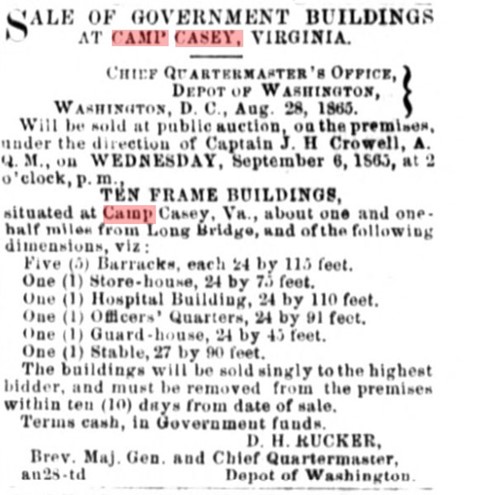
-
- [1]“Sale of Government Buildings at Camp Casey,” Daily National Republican, Second Edition, August 30, 1865. Terms of the sale required the winning bidder to remove the structures within ten days of sale.
-
- [2]Revised U.S. Army Regulations, 1863, pp. 76-78.
-
- [3]Gaede, Frederick C. and Coates, Earl J., eds. The 1865 Quartermaster’s Manual, Gettysburg, PA 2013, pp.15-22
-
- [4]Monthly Returns of the Post, Camp Casey Virginia, on microfilm in the National Archives.
AHS thanks Michael A. Schaffner for these articles on the Civil War 2nd and 23rd US Colored Troops and on Camp Casey. Mr. Schnaffer has given presentations to Civil War Round Tables around the country as well as at the Museum of Civil War Medicine and to the Arlington Sesquicentennial Committee. In 2014 he gave the keynote speech for Arlington’s rededication of Fort Ethan Allen. He is also a Civil War reenactor, attending battle reenactments and living histories in both blue and gray, and at ranks from private to major. After “commanding” a “battalion” of United States Colored Infantry reenactors at the 150th anniversary reenactment of the Battle of New Market Heights in 2014 he gave away his gray uniform and equipment, did a stint as a volunteer at the African American Civil War Museum in Washington, and is now a member of Company B, 54th Massachusetts, the “Glory” regiment. He is also a member of the AHS Board of Directors.
Freedmans Village
During the Civil War, freed, escaped, and former enslaved people fled north to US Army camps in search of freedom, protection, and refuge. As these camps often became overcrowded, the federal government dedicated funds, resources, and access to a site in Arlington Heights that would serve as a planned community for the influx of African American refugees. This planned community was envisioned to provide freed and formerly enslaved people with not only suitable housing, but also with access to education, labor training, and other foundational opportunities found in any free community.

Harper’s Weekly image of Freedmans Village, published May 7, 1864
Known as Freedmans Village, the community was formally dedicated on December 4, 1863 and was located on a portion of the US Army-occupied Custis-Lee Plantation which later became Arlington National Cemetery. The Freedmans Village quickly became the model for other planned free-to-slave communities. It prospered and functioned with relative autonomy by the dedication and diligence of its residents. In the Freedmans Village, male residents worked for pay in support of the defense of the city, while the women sewed uniforms and worked the village gardens and fields. Eventually, the village consisted of more than 50 two story duplex houses, a school, two churches, a meeting hall, and a hospital and accompanying home for the aged and infirmed.
Though the village was intended to be temporary, its population exceeded 1,000 and the residents lived in the community until the late 1890s. Formally designated as a military reservation in 1883, residents faced government pressure to leave and by 1898, the last of the Freedmans Village residents vacated their homes. Many of the village resident continued to live in the Arlington region, developed their own communities in areas such as Arlington View, Queen City (East Arlington), and Green Valley (formerly known as Nauck), among others.
This panoramic view of Freedmans Village is the printed engraving published in the May 7, 1864 edition of Harper’s Weekly. This engraving is regarded as an authoritative image of Freedman’s Village after it was established in May of the previous year. It was a haven for formerly enslaved people who had escaped the confederate states during the Civil War. This was one of the first views much of the country had of a community of freed slaves living unenslaved and productive lives.
Harper’s Weekly was the most widely read journal in the United States during the Civil War. Some of the most important articles and illustrations of the Civil War were in Harper’s reporting on the war.
This image now serves as part of the logo for the Black Heritage Museum of Arlington. The site of Freedman’s Village is now part of Arlington National Cemetery. It is commemorated by historical markers nearby in a small park at Southgate Road and South Oak Street.
This broadside, issued soon after Freedmans Village was established, had the regulations for the government of the Freedmans Village at Greene Heights, on the grounds of the Arlington estate. In 1863, Lieutenant Colonel Elias M. Greene, Chief Quartermaster of the military department of Washington, D.C., set up the community for some of the many freed people who escaped slavery during the Civil War. A broadside was a sizeable piece of paper printed that was posted for all to see, similar to today’s poster.

Regulations, Freedmans Village, Greene Heights, Arlington, VA, 1863. Click here to read a transcript of the regulations for Freedmans Village.
Anyone arriving at the village was given “comfortable clothing, rations, and the best quarters which can be assigned them.” Men and women were assigned to “duty” in the workshops and “able-bodied field hands” were sent to nearby government farms. Children attended school in the Village. The sick were cared for in an on-site hospital and those who were too old to work were given housing and care.
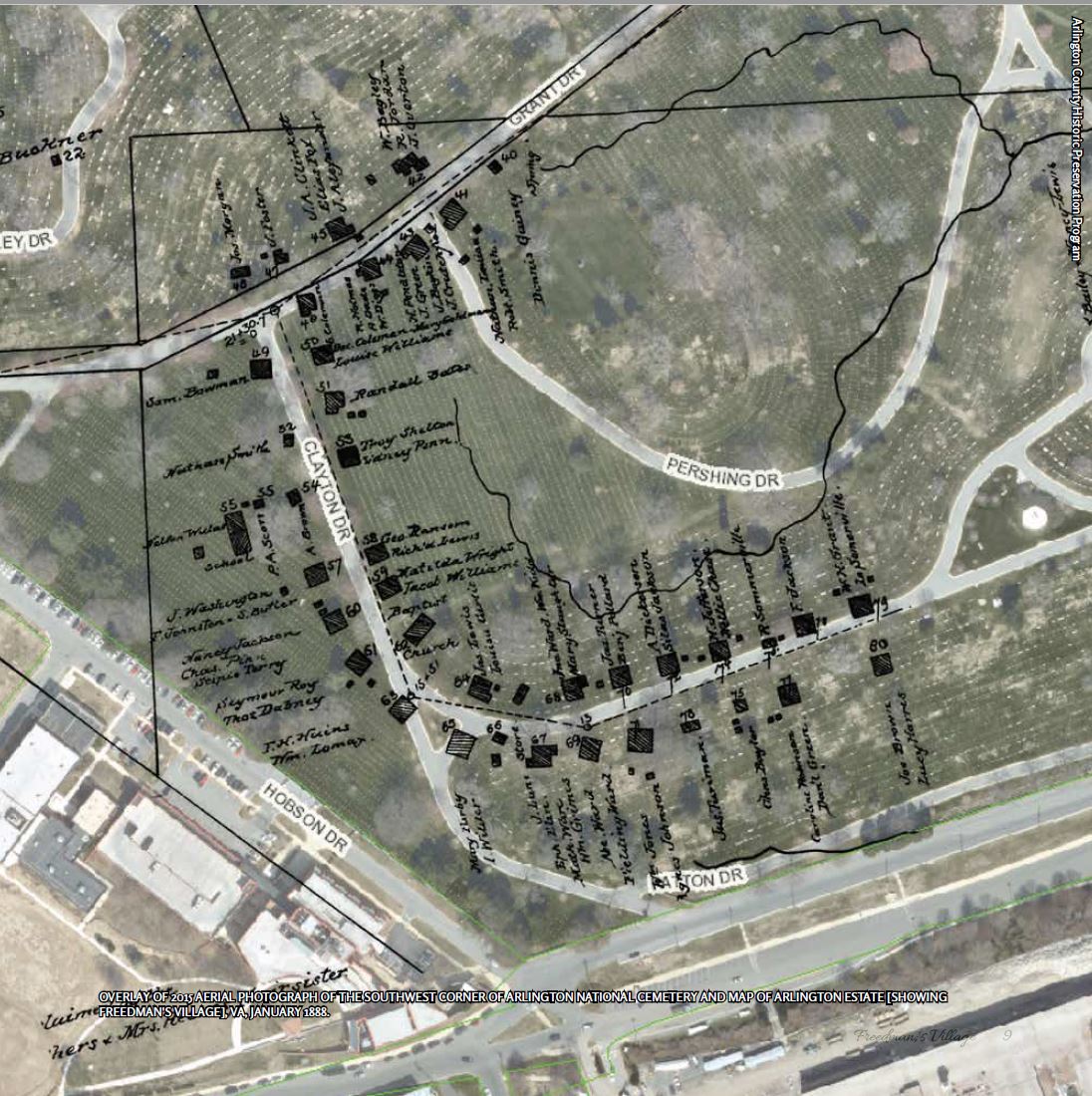
Map overlay showing where Freedmans Village was located on today’s roads in the Arlington National Cemetery. (courtesy, Arlington County)
James Parks (1843-1929)

James Parks was born enslaved in 1843 at the Arlington estate. Once freed, he continued to work on the grounds, digging the first graves for fallen soldiers during the Civil War.
Parks provided critical information to our understanding of how the estate functioned and how the enslaved lived. He gave specific locations for the wells, springs, slave quarters, the slave cemetery, dance pavilion, old roads, icehouse, blacksmith shop, and kitchens. He left behind one of the few published accounts from an enslaved person and it became the basis on which Arlington House was restored. His testimony provides a more complete record of the people who inhabited the plantation: the enslaved people and the Custis-Lee family.
When Jim Parks died in August of 1929, he received special permission from the US Secretary of War to be buried at Arlington National Cemetery with full military honors. He is the only person buried in Arlington Cemetery who was born on the old plantation.
High View Park (Hall’s Hill) Segregation Wall, c. 1930

This is a section of the Segregation Wall in the High View Park neighborhood (formerly known as Hall’s Hill). In the 1930s Arlington County built this wall to separate the white Woodlawn Village subdivision from Hall’s Hill which was populated by African-Americans. In this section, the wall facing the African-American community was a dull cement block. The part of the wall facing the white community was red brick. The wall was often at least six inches thick. It was of various heights, all of which were at least six feet and had an uneven and, in some places, a jagged top to prevent climbing over it. The only through street in Hall’s Hill was North Edison Street making it time consuming for residents to make their way out of the neighborhood from their homes near the wall. Not until 1966 did the county remove some of the wall to allow full access to and from Hall’s Hill.
A heavy rainstorm in 2019 washed away parts of the remaining wall in Laura Rogers back yard and she donated parts of the wall to the Arlington Historical Society, the Black Heritage Museum of Arlington, and to the John M. Langston Citizens’ Association of High View Park.
Memory Bricks

Local artist and native of High View Park, Winnie Owens-Hart, commemorated her neighborhood with brickwork of a different kind. This artwork reflects the history and the values of this predominantly African-American community. The artwork grew out of a summer employment program for creative youth who created decorative bricks and organized community events where residents could customize their own bricks. These brocks line the oval walkway in the park located at North Dinwiddie Street and North Cameron Street. They were installed in 2004.

A view of the High View Park walkway and Memory Bricks, image courtesy Winnie Owens-Hart and Arlington County.
Eyeglasses and Case Belonging to Dr. Charles R. Drew

Dr. Charles R. Drew was an American physician, surgeon, and medical researcher in the field of blood transfusions. He developed new techniques for blood storage and applied his expertise to develop large-scale blood banks early in World War II. His work enabled medics to save thousands of lives on the battlefront. As the most prominent African-American in the field, Dr. Drew protested against the practice of racial segregation in the donation of blood because the racist practice of separating storing blood by race had no scientific basis.
Dr. Drew was born in Washington, D.C. in 1904 and graduated from Dunbar High School. He became a surgeon and scientist, and conducted research in blood and transfusions, blood chemistry, and the storage of blood. His ground-breaking findings, procedures, and standards for collecting, processing, and storing blood led to his appointment in 1940 as the head of the Blood for Britain Project to transport desperately needed blood and plasma from the US to Great Britain in World War II.
Dr. Drew was appointed Director of the first American Red Cross Blood Bank in February 1941. Among his innovations was the “bloodmobile” with mobile blood donation trucks with refrigerators. The work forged his reputation as a pioneer and earned him the title “Father of the Blood Bank.” At the time, African American blood was separated in supply networks however, Dr. Drew resigned from his post in protest after the armed forces ruled that African American blood would be stored separately from that of whites. Dr. Drew continued his research and taught at the Freedman’s Hospital at Howard University as a surgeon and professor of medicine. He received multiple awards and acknowledgements for his contributions to medicine.
Dr. Charles Drew married Minnie Robbins and they and their three daughters and one son lived at 2505 1st Street, South, in Arlington. He died in 1950 in a car accident on the way back from a medical conference in Alabama. His house in Arlington is a National Historic Landmark and many parks and public buildings have been named for him in the US and abroad, including in Arlington, the Charles R. Drew Elementary School, the Charles R. Drew Community Center, and Drew Park.
These glasses were donated to AHS by Evelyn Syphax Reid in 1979.

Virginia State Pupil Placement Form, 1958

Dorothy Hamm completed this Pupil Placement Form in 1958 for her elder son, Edward Leslie Hamm, Jr. She completed it under protest.
Completing this form was required to enroll any student in school in the state and it was used to screen out African-American students from white schools. This form was deemed illegal by the Federal Court of Appeals. Despite the court ruling, the state continued to use the Pupil Placement Form as an obstacle to desegregation. This form was completed by Dorothy Hamm, under protest, in an effort to enroll her elder son, Edward Leslie Hamm, Jr in Stratford Junior High School for the 1958-1959 school year.
The US Supreme Court ruled in 1954 that separate schools for white and for African-American children was inherently unequal and therefore unconstitutional and illegal. This form represents years of court cases, degrading processes, and institutional racism the African-American community had to endure to get their kids into better schools
In August 1958, the Virginia Pupil Placement Board mailed a notice to all the African-American families trying to enroll their children in white schools that they would have to meet with the Pupil Placement Board. The board would examine their child for placement in a white school. Families were forbidden from having a lawyer present. As a result, no family kept their appointment in protest.
The Pupil Placement Board eventually reached agreement with the families that they could have legal advisors present at the appointments and the appointments began. Birchell S. Hilton, Executive Secretary of the Pupil Placement Board for the county, asked each family questions such as: “Is this application being made solely to enforce the so-called constitutional right?” In addition, the children’s mental health, IQ, demeanor, and grades were assessed to determine if the child could enroll in a white school.
The Pupil Placement Board rejected all 28 Arlington African American students seeking to transfer to white schools. In September, the families returned to court and it was revealed that their children were disqualified for one or more of the following reasons:
-
- Attendance area: students did not live closer to a white school than any other, 11 were disqualified for this reason
-
- Overcrowding at Washington-Lee High School: 5 students were disqualified
-
- Inadequate academic achievement: 22 students were disqualified, however, the IQs and grades for several African-Americans were above the white norm and some, such as E. Leslie Hamm, Jr., were honor students.
-
- Undefined psychological problems: 7 students were disqualified
-
- Undefined adaptability: 5 students were disqualified
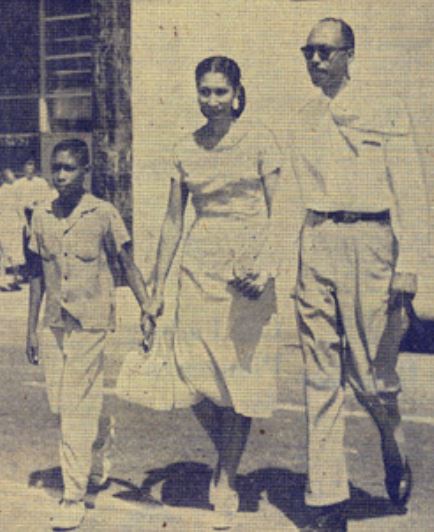
Washington Post photo taken as the Hamm family left the Pupil Placement examination in 1958. (left to right: E. Leslie Hamm, Jr., Dorothy Hamm, E. Leslie Hamm, Sr.) This Washington Post-Times photo was published on August 19, 1958. The article is on loan to AHS from Carmela Hamm
The federal judge ruled that the pupil placement process was not discriminatory and he agreed that the students should not be transferred to white schools. However, the judge also ruled that the criteria for the four students Ronald Deskins, Michael Jones, Lance Newman, and Gloria Thompson was invalid, and he ordered the four to transfer to Stratford Junior High School starting in 1959.
The Hamm pupil placement form is on loan to AHS from Carmela Hamm, the daughter of Dorothy and E. Leslie Hamm, Sr.
The four approved students who were allowed to enroll at Stratford Junior High School starting on February 2, 1959 were the first children of color to enroll in white schools in Virginia. It was a peaceful event–unlike others around the country–but riot-ready police presence was heavy nevertheless.
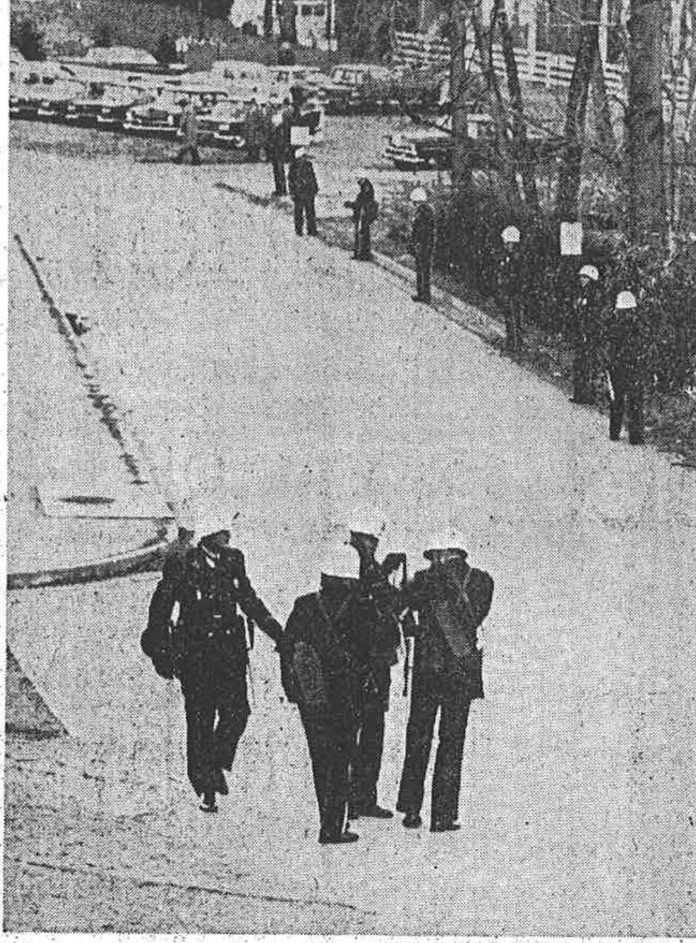
This photograph was published in The Washington Post on February 3, 1959 and is on loan from Carmela Hamm. Police expected violence like much of the rest of the country. The entire police force lined the road to the school, but no violence occurred.
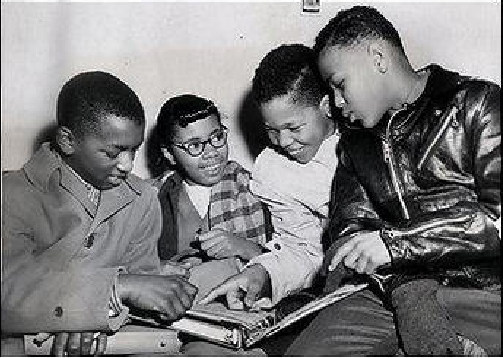
The first four African-American children who were the first enroll in a white school in Virginia. This photo was taken in a lighter moment after the first day of school. (Left to right: Ronald Deskins, Gloria Thompson, Lance Newman, and Michael Jones)
Fireman Helmet and Boots Belonging to William “Bill” Warrington

William “Bill” Warrington, Photo courtesy, Shari Warrington Riddick and Carmela Hamm
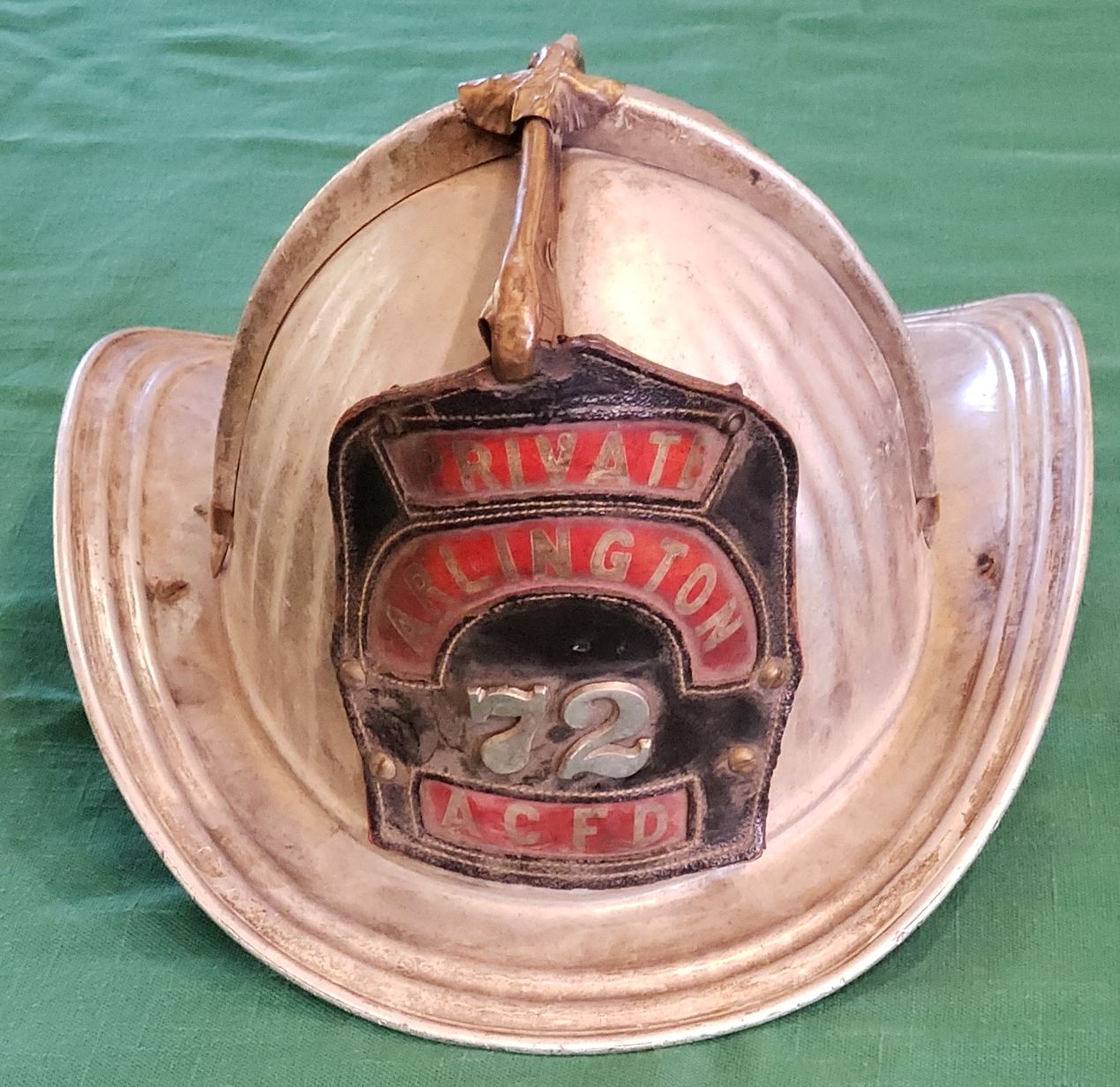

These helmet and boots belonged to African-American Fireman, William “Bill” Warrington. Hired in 1952, he was one of the original paid firefighters of Hall’s Hill’s Fire Department.
In 1918, a group of African-Americans from the Hall’s Hill neighborhood got together to volunteer as firefighters. They became the Hall’s Hill Volunteer Fire Department (HHVFD). A second African-American volunteer unit was formed in 1925 in the East Arlington (Queen City) neighborhood but it was disbanded when residents were removed in preparation for the construction of the Pentagon.
Arlington County hired its first paid white firefighters in 1940 and it began paying its first African-American firefighters 12 years later and Bill Warrington was one of them. Black firefighters faced racism even as they arrived to help white families whose homes were engulfed. According to the an oral history featured on the Arlington Fire Journal and Metro DC Fire History blog, they faced slurs from the people they were trying to aid, including a man whose home was on fire.
When Station No. 8 was racially integrated in the early 1960s, Alfred Clark, the county’s first African American fire captain, faced a mutiny by some of the white firefighters who refused to serve under a Black station captain. Racist slurs were written in the station house. A battalion chief came and ordered the words removed told the white firefighters that they would serve and would respect Captain Clark.
AHS is grateful to Shari Warrington Riddick, daughter of Fireman Bill Warrington, for the artifacts and photographs that she has generously shared with us.
Sit-In Protests
Lunch counter sit-in protests occurred in Arlington to protest segregation. Several occurred on June 9, 1960.
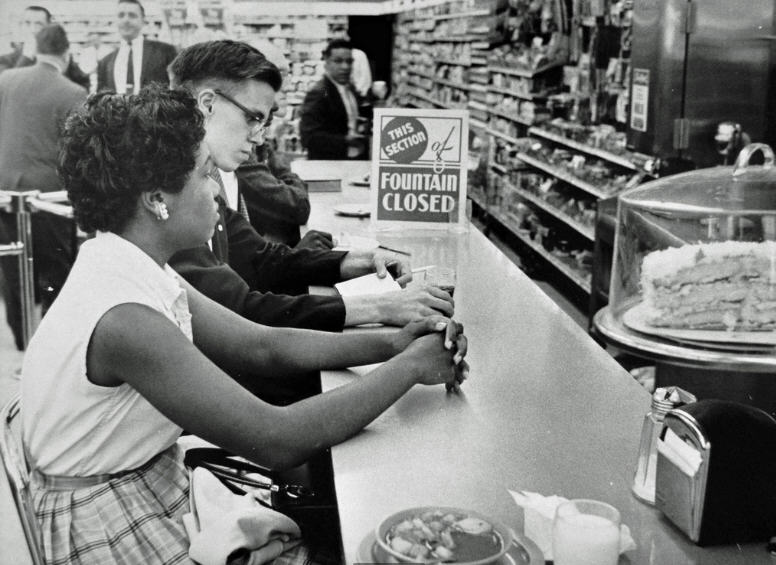
Black and white protesters protested segregation of services at the People’s Drug Store in North Arlington. The lunch counter closed while the protesters were present, but later relented.
Shown in the photo above, closest to the photographer was Gwendolyn Greene (later Britt) sitting patiently at the People’s Drug counter on the 4700 block of Lee Highway in Arlington, Virginia during a sit-in protest on June 9. The workers behind the counter served white customers then walked out when demonstrators sat down, only returning when the management closed the counter (note sign).
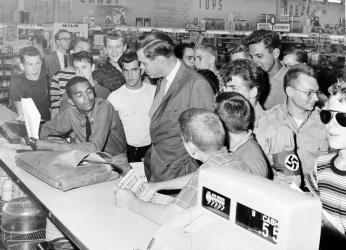
At some protests, American Nazi Party leader, George Rockwell, who lived in Arlington, came to taunt the protesters. His followers and other white residents would dump salt, pepper, or condiments on the protesters. Protesters often went through training designed to help them keep calm and respectful, despite the efforts to disgrace and harass them.
They were taunted by members of the Nazi party whose uniforms had swastikas on their shirts and by some young white toughs.
The protestors were part of the Non-Violent Action Group (NAG), an integrated group mainly composed of students that was led by Howard University divinity student Laurence Henry. The sit-in demonstrations at People’s Drug Store, Drug Fair, Landsburgh’s Woolworths and the Howard Johnson’s in Arlington were successful within a matter of weeks and most restaurants and lunch counters in the city desegregated in 1960.
The group moved on to Maryland the same year where they staged ultimately successful demonstrations to desegregate Glen Echo Amusement Park, the Hi-Boy restaurant in Rockville and the Hiser Theater in Bethesda.
Greene was part of a group with four others arrested on the carousel at Glen Echo in a case that ultimately went to the Supreme Court. The Court ruled in the protestors’ favor and overturned the arrests because the park had used deputy sheriffs to enforce its Jim Crow segregation policies. Greene went on to become a state senator in Maryland, Gwendolyn (Greene) Britt.
These may have been among the most peaceful of the sit-ins that occurred throughout the South to highlight the injustice of not being able to eat together. No dogs were set on them in Arlington and they were not beaten and dragged away as in other places. But they didn’t know that wouldn’t happen when they say down. Their courage and determination were powerful. (Photos by Paul Schmick. Courtesy of the D.C. Public Library Washington Star Collection © Washington Post.)


